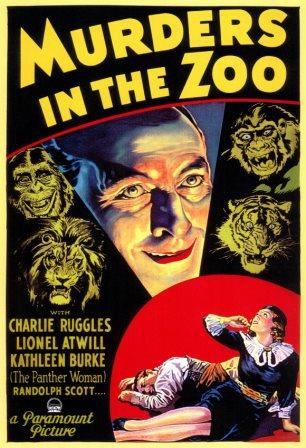“An ingenius device for the right occasion. You’ll never lie to a friend again, and you’ll never kiss another man’s wife.”
Paramount was a touch behind leader Universal Studios when it came to horror movies. Starting with 1931’s Dr. Jekyll and Mr. Hyde, Paramount’s horror entries focused on more “mundane” horrors such as sadism, leaving the classic monsters of Frankenstein and Dracula to Universal.
Among their earliest entries was 1932’s Island of Lost Souls and today’s topic, 1933’s Murders in the Zoo. If you look only at the short running time of just over an hour, you’d think there wouldn’t be much to talk about. But yet there is!
Though getting second billing (more on that later) is Lionel Atwill as Eric Gorman, a big game hunter who captures exotic game for the local zoo. On top of his rather peculiar obsession with animals- he’s patterned his own moral code to mirror their’s in “They love, they hate, they kill!” – he’s also insanely jealous, to put it mildly.
As we open Gorman is on safari hunched over a beast he’s just cornered. A moment later we learn that this “beast” is actually a man who tried to kiss his wife. As penance Gorman has not only tied the poor man’s wrists behind back but has also sewn his mouth shut before abandoning him alone in the jungle.
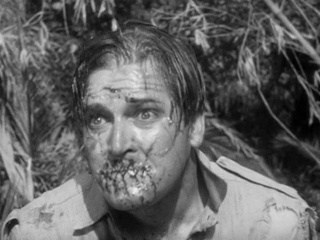 On the journey back to the zoo, Gorman has a minor run in with another of his wife Evelyn’s (Kathleen Burke) beaus in the form of Hewitt (John Lodge). Could he be the next victim? Back at the zoo we meet another duo of players in the form of Dr. Jack Woodford (Randolph Scott) and his assistant Jerry (Gail Patrick).
On the journey back to the zoo, Gorman has a minor run in with another of his wife Evelyn’s (Kathleen Burke) beaus in the form of Hewitt (John Lodge). Could he be the next victim? Back at the zoo we meet another duo of players in the form of Dr. Jack Woodford (Randolph Scott) and his assistant Jerry (Gail Patrick).
Rather than twisting and turning, the plot pushes headlong with few surprises outside of when the mad Gorman will be caught. In an odd twist for the time, we are presented from the start who the villain is and the suspense is created (much like the Columbo series) in learning how the culprit will take with him before he’s cornered- which of course he ultimately is.
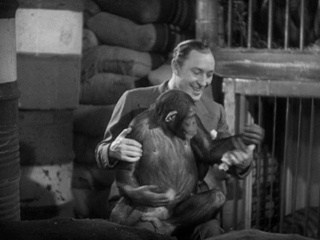 Atwill, an actor most known for playing heavies, is excellent as Eric Gorman. His delivery and tone show not only a mastery of the material but seems almost overly comfortable with the myriad of animals in the picture. At one point he sits amiably during a conversation with a chimpanzee on his lap before gently taking the chimp’s arm and offering it in greeting to his colleague.
Atwill, an actor most known for playing heavies, is excellent as Eric Gorman. His delivery and tone show not only a mastery of the material but seems almost overly comfortable with the myriad of animals in the picture. At one point he sits amiably during a conversation with a chimpanzee on his lap before gently taking the chimp’s arm and offering it in greeting to his colleague.
The one alarming criticism justifiably leveled at Murders at the Zoo is the presence of Charlie Ruggles as the publicity agent for the animals. Ruggles hams it up in every scene he is given, none of which are key to the plot in any way. In an attempt at humor his character is deathly afraid of animals and has an effected stutter when in their presence. Sadly, the closest poor Charlie gets to a laugh is late in the picture when he is cleaning a cage and soils himself in fright on realizing there is a snake in the cage with him. (It is a pre-code picture, after all.)
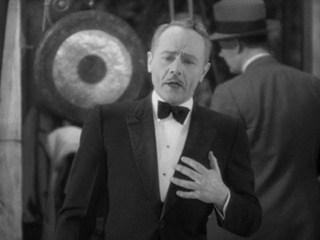 Perhaps Ruggles was added to lighten the mood and give Murders at the Zoo a bit of everything. In this regard one must admit grudgingly that Ruggles’ addition does add some levity to the proceedings, even though his character is a one-trick pony and is completely dispensable to the plot. Surely he was given top billing as a Paramount contract star at the time.
Perhaps Ruggles was added to lighten the mood and give Murders at the Zoo a bit of everything. In this regard one must admit grudgingly that Ruggles’ addition does add some levity to the proceedings, even though his character is a one-trick pony and is completely dispensable to the plot. Surely he was given top billing as a Paramount contract star at the time.
The other duo which needs mentioning is Randolph Scott and Gail Patrick. Scott’s generally agreeable if perhaps overtly so as the scientist working on creating an antivenom for the dreaded green mamba that Gorman has brought back from Southeast Asia (though the snake is native to Africa). Outside of the seriously misguided decision to accuse Gorman then walk away without first sharing his thoughts with anyone else there isn’t much to complain about. Just don’t expect a flamboyant hero here!
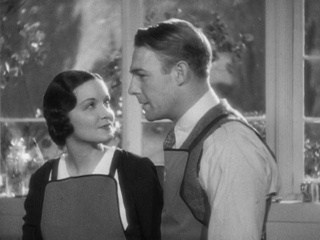 In Gail Patrick it is easy to see why she came close to winning the role of the Panther Woman in The Island of Lost Souls that eventually went to co-star here Kathleen Burke. Though in this case she too isn’t the stereotypical research assistant. Though we don’t get to see much of her here, ultimately she did win the career contest (if there is such a thing), having a much longer career than the Panther Woman herself.
In Gail Patrick it is easy to see why she came close to winning the role of the Panther Woman in The Island of Lost Souls that eventually went to co-star here Kathleen Burke. Though in this case she too isn’t the stereotypical research assistant. Though we don’t get to see much of her here, ultimately she did win the career contest (if there is such a thing), having a much longer career than the Panther Woman herself.
The final stars of Murders in the Zoo are of course the animals themselves. On the positive side they are wonderful in the picture and in some cases provide as much drama and thrills as Gorman himself. On the negative side are many of the things you’d expect from a film of this pedigree. Cages are seemingly painfully small with barely room for tigers and lions to turn around. Bear cubs are chained a few feet from spectators who seemingly are able to give them bottles of milk to drink- much like you’d feed a giraffe today.
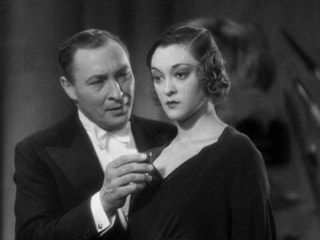 Lastly and perhaps most egregiously is the mass release of the carnivores towards the end of the picture. Here lions and tigers and more (but no bears- oh my!) race through the zoo snapping and clawing at one another in what may have been an induced frenzy. Though only this last instance was critical to the plot surely more humane approaches were available.
Lastly and perhaps most egregiously is the mass release of the carnivores towards the end of the picture. Here lions and tigers and more (but no bears- oh my!) race through the zoo snapping and clawing at one another in what may have been an induced frenzy. Though only this last instance was critical to the plot surely more humane approaches were available.
Though perhaps not on many’s must see list, Murders in the Zoo is a good watch for anyone, even with the obnoxious intrusions of Charlie Ruggles. There’s plenty of excitement and a good story and the addition of Lionel Atwill in a rare leading role make this a quick hour!
